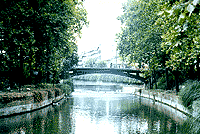 Sights:
Sights:The Byzantine fortress, the archaeological site near the Greek Orthodox cathedral (metropolis) of Aghios Nikolaos, which is attributed to an Asklepieion, the old neighbourhood of Varousi below the castle, the old churches.
Museums - Art Galleries:
Municipal Folklore Museum Municipal Art Gallery Collection of 16th-19th century icons
Kalambaka:
349 km from Athens, 22 km north of Trikala.
En route to the monasteries at Meteora the visitor passes through Kalambaka, built in the foothills of the majesic grey crags.
On top of a hillock stands the Greek Orthodox cathedral (metropolis), dedicated to the Dormition of the Virgin, (first half 12th c.), with valuable icons and wall paintings.
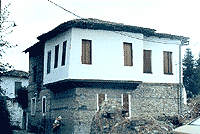 A short distance south of Kalambaka is Theopetra, an impressive rock with a cave of archaeological importance, which has yielded evidence of occupation from the Palaeolithic to the Neolithic Age.
A short distance south of Kalambaka is Theopetra, an impressive rock with a cave of archaeological importance, which has yielded evidence of occupation from the Palaeolithic to the Neolithic Age.To the southwest of Trikala (18 km away) is the town of Pyli or Porta, guarding the narrow pass between Thessaly and Epirus, through the Pindos Mountains. Here flows the river Portaikos, a tributary of the Pineios. The Pyli defile, with a watermill, is shaded by towering plane trees. At the base of Mount Koziaka (former Kerketion) is a rock with remains of ancient defensive walls, site of the ancient city of Pialia.
Other places of interest in the area are:
The traditional settlement of Porto Panaghia with its cobbled streets and thriving orchards.
The church of Porta Panaghia, one of the most important Byzantine monuments in Greece (1283), is built on the site of a sanctuary of Athena or Apollo, from which the spolia incorporated in its masonry were taken.
The Monastery of Aghios Vissarion, tel.: (04340) 22.420, 2 km further north, of Pyli was founded in 1522 by Saint Vessarion. Built like a fortress, it is surrounded by a wall 10 m high.
The Convent of the Koimesis tis Theotokou (Dormition of the Virgin) stands 5 km south of Pyli on a slope of Mount Itamos.
The stone humpback bridge – a scheduled historical monument – was built under the direction of Saint Vessarion (1514-1518).
The little village of Pertouli (48 km west of Trikala) is one of the best winter resorts in Thessaly. At Pertouliotika Livadia, 3 km northeast of it, there is the Koziaka ski center. Information: Ski Center, tel. (04340) 91.385.
Neraidochori (52 km west of Trikala) is built on a pine-covered hillside.
The beautiful mountain village of Elati is a stopping place for the Koziaka refuge and ski center.
Meteora
The monasteries, in order as the visitor ascends to Meteora from Kalambaka, are:
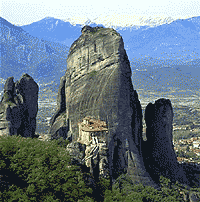 Monastery of Aghios Nikolaos Anapafsas
Monastery of Aghios Nikolaos Anapafsas
Founded around 1500 by the Metropolitan of Larissa, Dionyssios, it is named after an old patron, Anapafsas. The katholikon, of cruciform plan with wide narthex, was decorated with wall paintings in 1537, by the renowned Cretan iconographer Theophanes Bathas-Strelitzas.
Information: tel.: (04320) 77.392.
Roussanou Monastery
Founded in 1545 by the Epirote brothers Joasaph and Maximos, who built the monastery church upon the ruins of an earlier one dedicated to the Metamorphosis tou Sotiros (Transfiguration of the Saviour). Its name is probably due to an earlier hermit founder. The katholikon is of Athonite type, of cruciform plan with high dome. It is decorated with wall paintings of outstanding art (1561), a gilded woodcarved iconostasis, noteworthy panel icons and icon-stands (proskynetaria).
Information: tel.: (04320) 22.649.
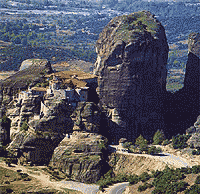 Varlaam Monastery
Varlaam Monastery
Founded in 1517 by the brothers Theophanes and Nektarios Apsaradas from Ioannina. However, the first to establish a monastery was the ascetic anchorite Varlaam, after whom it is named. The katholikon, dedicated to the Aghii Pantes (All Saints), was adorned with wall paintings in 1548 by the well-known Post-byzantine iconographer Frangos Katelanos; it was renovated in 1780. The monastery houses an important collection of valuable codices, reliquaries, intricately carved wooden crosses, gold-embroidered epitaphioi, icons and other ecclesiastical treasures.
Information: tel.: (04320) 75.386.
Megalo Meteoro (Metamorphosis)
The first church of the Metamorphosis (Transfiguration) was founded by Athanasios, surnamed the Meteorite – one of the outstanding figures of Orthodox monasticism – before 1382 and was completed by the monk Joasaph. The katholikon is in the Byzantine order with a twelve-sided dome at the center, 24 m high. Its decoration with wall paintings commenced in 1484; it was renovated in 1545 and adorned with new wall paintings in 1552. These last are among the loveliest works of Post-byzantine mural art, executed by the great Cretan iconographer Theophanes. There are also many notable panel icons of the 14th and 16th centuries. The refectory houses the monastery’s museum collection.
Information: tel.: (04320) 22.278.
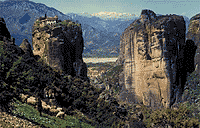 Aghia Triada Monastery
Aghia Triada Monastery
Founded by the monk Dometius in the 15th century. The church was decorated with wall paintings in the 18th century, by the brothers Antonios and Nikolaos. On the way up the 140 rock-hewn steps to the monastery, one passes the chapel of Aghios loannis o Prodromos (Saint John the Baptist), with wall paintings dated 1682.
Information: tel.: (04320) 77.123.
Convent of Aghios Stephanos
The only convent at Meteora, with an unimpeded view over the plain towards Kalambaka. It is not known when the old church was founded, but the present katholikon, dedicated to Aghios Haralambos, was built in 1798. The saint’s skull, a gift to the nunnery from Prince Vladislav of Wallachia, is kept here. The church of Aghios Stephanos is an aisleless, timber-roofed basilica, adorned with wall-paintings executed in 1545 by the priest loannis from Stagoi. The convent houses precious ecclesiastical treasures.
Information: tel.: (04320) 22.279.
To the east of the road towards the Meteora is the church of the Panaghia Doupiani, with wall paintings and a wood carved iconostasis.

